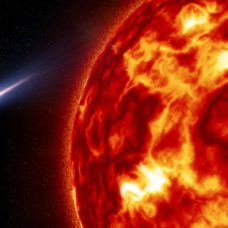Now lifeless, astrobiologists say that life on the Moon could have been possible billions of years ago during two separate periods.
Earth’s only natural satellite is the closest astronomical body to us, yet it remains an unknown quantity.
Scientists aren’t sure how the Moon came to be, can’t say why it has such a unique inclined orbit, don’t know why it’s so large compared to its host planet, and can’t explain all its rock composition, among other lunar mysteries.
The Moon has fascinated us to the point that we built spaceships specifically to land on it. Moonwalkers brought back lunar geologic samples and thousands of pictures that only added to the mystique surrounding the Moon.
In recent years, we witnessed a revival of interest in the Moon among the world’s leading space agencies and companies, each with its own lunar agenda.
Read More: Dutch NCLE Radio Antenna Joins Chinese Mission to Far Side of the Moon
One of the unsolved puzzles about our nearest neighbor is whether life on the Moon has ever been possible. Because, although it looks uninhabitable today, we can’t rule out the possibility of past life.
Early Moon had Two Habitability Windows
According to the international principle of “common heritage of mankind“, the Moon doesn’t belong to any person, entity, or government, which is to say it belongs to everyone.
Maybe it doesn’t belong to us, or in other words, it belonged to other lifeforms long before our species appeared on Earth.
Billions of years ago, and over two distinct periods, the Moon had the ingredients necessary for life to appear, says a new study.
Two astrobiologists from the U.S. and the U.K., Dirk Schulze-Makuch (Washington State University) and Ian Crawford (University of London) showed that there were two periods during its evolution where life on the Moon could have existed.
Schulze-Makuch and Crawford say that 4 billion years ago, shortly after its formation, and again around 500 million years after, conditions on the Moon surface could have enabled the emergence of simple lifeforms.
Sorry moonwalkers Armstrong and Aldrin, you may not be the first lifeforms to grace the lunar surface!
Now, the Moon is bereft of atmosphere, a magnetic field, and is short on water. However, the two planetary researchers think this wasn’t always the case.
At least during those two periods, and under various circumstances, the Moon gushed out huge quantities of superheated gases and water vapor.
According to the study, this outgassing could build up an atmosphere 3 times as massive as Mars’s current atmosphere and enabled the presence of liquid water pools on the lunar surface.
Moon Alien, Where Art Thou?
The Moon is relatively big when we look at Earth and other planetary satellites.
With a diameter of 2,159 miles, the Moon is roughly quarter the size of Earth, and proportionally to its host planet; it’s one of the largest moons in the solar system.
The Moon size doesn’t necessarily mean it may have been habitable once, but it’s one of the lunar mysteries that emphasizes its uniqueness, like its tilted orbit, relative closeness to Earth, and now the possibility that it had twice gathered ingredients for life.
Previous research has shown that the Moon isn’t as dry as it appears to be. It still has large quantities of water, but only in the form of ice deposited in shadowed craters and other spots.
“If liquid water and a significant atmosphere were present on the early moon for long periods of time, we think the lunar surface would have been at least transiently habitable,” said Schulze-Makuch.
Researchers also think that a magnetic field would’ve formed during the two windows.
As to how any lifeform could’ve emerged, they think it would have followed the same process that occurred on Earth and “the more likely scenario is that it would have been brought in by a meteorite.”
Early Earth and early Moon seem to have had a lot in common.
Read More: Where did it all Begin? The Theory of the Beginning of Life
However, the conditions for life that were present on early Earth did allow simple organisms to evolve and spin into a stupendous array of complex lifeforms.
The same didn’t happen on the Moon. Or did it?
Here’s another intricate lunar puzzle that scientists have yet to piece together.
Some metals found in lunar rocks, like Uranium 236, Neptunium 237, and Brass, as far as our scientific knowledge goes, can’t be formed naturally and can only be produced through artificial processes, usually as byproducts of nuclear reactions.
From where did these “processed metals” come?
The very existence of the Moon is thought to be a rare irregularity. “It seems much easier to explain the non-existence of the Moon than its existence,” said NASA scientist Robin Brett.
There are some lunar characteristics and anomalies that suggest the Moon might be hollow, unlike any astronomical body astrophysicists know of.
Although farfetched, until there is a valid answer behind all of these mysteries, it’s impossible to tell the true origins and history of our moon.



















Comments (0)
Most Recent